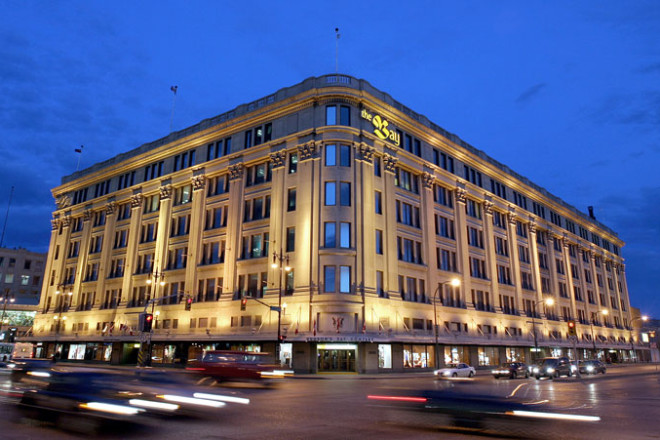Winnipeg’s iconic Hudson’s Bay Company building gains heritage status, but city wrestles with its future
One of Winnipeg’s most iconic buildings, the Hudson’s Bay Company Store on Portage Avenue, received heritage designation from Winnipeg City Council on March 21, 2019. While this historical resource listing gives the massive 1926 landmark a measure of protection, its future role in the city opens up important questions. “The Bay building presents some challenges for our city,” says Wins Bridgman, Co-Director of Bridgman Collaborative Architecture, “but also a tremendous opportunity to rethink what “heritage” means in a post-colonial city.”
HBC built the Winnipeg department store as its Canadian flagship, prominently situating it at the corner of Portage Avenue and Memorial Boulevard with sightlines to the nearby Manitoba Legislature. The grand retail emporium provided 650,000 square feet of retail space spread over 6 storeys, including multiple restaurants and even an HBC museum reflecting the company’s key role in the colonization of Western Canada. The Bay building was also a monument to locally sourced materials and construction might, with 125,000 cubic feet of Tyndall limestone cladding on its Beaux-Arts exterior, as well as local steel and roofing materials. When it opened, it was the largest poured reinforced concrete building in Canada, a method that offered great load-bearing strength, rigidity, and fire-resistance. Over the past two decades, however, HBC’s retail footprint in the hulking building has shrunk to two floors, with the rest left unoccupied. Rumours have swirled since at least 2002 that the retailer would move out of the downtown building completely, leaving its future in limbo.
The stakes around the adaptive reuse of The Bay building are even higher because many in Winnipeg are keen to avoid a rerun of what happened to the Eaton’s Building five blocks east on Portage Avenue. A similarly iconic and grand department store, the 1905 Eaton’s was 700,000 square feet of retail space on 8 floors, with an extraordinary building system comprised of steel beams, cast iron columns and 45 centimeter square wooden beams. It was an infinitely adaptable and beloved building – a civic symbol. And yet, with the bankruptcy of the Eaton’s retail chain in 1999, the future of the Winnipeg building was thrown into question. Debate raged for months over whether it should be demolished to make way for the True North arena project (now Bell MTS Place, home of the Winnipeg Jets) or preserved and adapted. In the end, after political wrangling and a court injunction that went all the way to the Supreme Court of Canada, demolition began on the Eaton’s building in July 2002.
Spurred in part by these still–painful civic memories, a steady stream of adaptation proposals have been made in recent years. Two provincial entities, Manitoba Hydro and Manitoba Liquor and Lotteries, looked at turning the building into their headquarters, while the Winnipeg Art Gallery considered housing its Inuit Art Centre there. The University of Winnipeg even proposed integrating the building into its campus as the University of Alberta’s had done with Edmonton’s downtown Bay in 2005. Even though the HBC offered the building to the University for a dollar there was difficulty raising funding for the conversion, and the proposal floundered.
Many of the recent proposals for The Bay building leverage the company’s 350 year history – including how it shaped relationships between Indigenous and non-Indigenous peoples in Western Canada – to inform the future uses for the building.
“Why not look at the adaptive reuse of The Bay as an opportunity to advance reconciliation?” asks Rae St. Clair Bridgman, planning professor at the University of Manitoba. “The conversation around preservation of the building needs to shift away from ideas about preserving Eurocentric cultural values from Winnipeg’s past. Discussion around the building should actively engage with each other about multiple social and cultural values, especially Indigenous ones. This is essential for building a future of reconciliation together.”
The complex questions surrounding the revitalization of this Winnipeg landmark are also being raised at sites across the country. The heritage designation of these places is just one of the tools that communities can use to foster an open dialogue about a site’s values and its future evolution.


